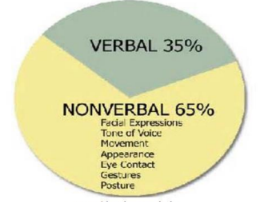Classifications of Human Communication
1/32
There's no tags or description
Looks like no tags are added yet.
Name | Mastery | Learn | Test | Matching | Spaced |
|---|
No study sessions yet.
33 Terms
Verbal Communication
The use of spoken and written words; language is the privileged medium.
Non-Verbal Communication
The intentional or unintentional use of non-spoken symbols to communicate meaning.
Gender affecting Verbal Communication
Masculine and feminine language styles may differ in tone, word choice, and expression.
Age affecting Verbal Communication
Generational differences affect vocabulary, style, and language use.
Regionality/nationality affecting Verbal Communication
Words and expressions vary depending on geographic or cultural background.
Education and occupation affecting Verbal Communication
They shape vocabulary, jargon, and expression styles (e.g., lawyers vs engineers).
Ethnicity and race affecting Verbal Communication
They influence pronunciation, meanings, and usage of words.
Factors Affecting Verbal Communication
Gender
Age
Regionality/nationality
Education and occupation
Ethnicity and race
Types of Non-Verbal Communication
Proxemics
Kinesics
Chronemics
Silence
Paralanguage
Clothing and Physical Appearance
Haptics
Territoriality
Olfatics
Proxemics
The study of how we use space in communication. E.g., respecting personal “human bubble.”
Kinesics
Body language such as gestures, movements, facial expressions, and eye contact.
Chronemics
The use of time in communication; culture-bound (e.g., punctuality vs. flexible time perception).
What can silence communicate?
Agreement, apathy, awe, confusion, contemplation, disagreement, embarrassment, regret, respect, etc.
Paralanguage
Vocal but non-word utterances that carry meaning. E.g., “Shhh.” “Hmm,” whistling, sighs.
How does clothing and physical appearance function as communication?
It conveys identity, status, and cultural meaning (e.g., uniforms, formal wear, tattoos).
Haptics
The study of touch in communication.
Types of Haptics
Social-polite (daily interactions)
Friendship touch (warmth, closeness)
Love-intimate touch (partners, family)
Demanding touch (dominance, power)
Professional/functional touch (doctors, hairstylists, no intimacy).
Territoriality
The space an individual claims temporarily or permanently (e.g., saving a seat with a bag.)
Olfatics
The use of smell in communication. Women are generally better at detecting, identifying, and remembering odors.
How do verbal and non-verbal communication complement each other?
Verbal conveys explicit content; non-verbal reinforces, contradicts, or substitutes meaning (e.g., saying “I’m fine” with a sad tone).
Which is harder to control: verbal or non-verbal communication?
Non-verbal is harder because many cues (facial expressions, tone, body language) are unconscious and spontaneous.
Why is non-verbal communication often considered more powerful than verbal?
It conveys emotion, attitudes, and relational messages more immediately and is often trusted more than words.
How can cultural differences affect non-verbal communication?
Cultures differ in personal space (proxemics), gestures, time orientation (chronemics), and touch norms (haptics).
How does power manifest differently in verbal vs. non-verbal communication?
Power may appear in verbal (commands authority language) or non-verbal (dominant posture, controlling space, demanding touch.)

According to the chart, what percentage of communication is verbal vs nonverbal?
Verbal = 35%, Nonverbal = 65%

Examples of nonverbal communication listed in the chart
Facial expressions
Tone of voice
Movement
Appearance
Eye contact
Gestures
Posture
Functions of Nonverbal Communication
Replacing spoken messages
Sending uncomfortable messages
Form impressions that guide communication
Makes relationships clear
Regulate interaction
Reinforce or modify verbal messages
Replacing Spoken Messages
Using gestures or expression instead of words (e.g., nodding instead of saying “yes”.
Sending uncomfortable messages
Conveys emotions indirectly when words may be awkward (e.g., avoiding eye contact to show disapproval).
Form impressions that guide communication
Appearance, posture, and tone; these shapes how others perceive and respond to us.
Make relationships clear
Signals closeness, status, or boundaries (e.g., touch, distance, tone).
Regulates interaction
Cues like eye contact, pauses, or gestures manage turn-taking in conversation.
Reinforces or modifies verbal messages
Nonverbal signals emphasize or change meaning (e.g., saying “I’m fine” with a sarcastic tone).